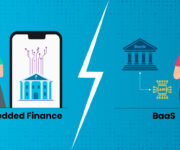Traditional lending practices are rapidly becoming obsolete as financial institutions seek more innovative credit solutions. This transformation is critical, given the IFC’s finding that 40% of formal MSMEs in developing countries face an annual financing gap of $5.2 trillion.
Accenture recently shed light on this transformation – their latest survey found 90% of businesses showing keen interest in newer trade finance products, marking a decisive shift toward alternative lending approaches.
Amidst various emerging solutions, anchor-based finance has caught the attention of industry veterans. The concept is straightforward: large, established companies serve as ‘anchors’ that help their smaller business partners access credit.
So, instead of poring over endless financial paperwork, lenders look at something far more telling—the actual business relationships and transaction patterns between these companies.
Let’s explore this topic in more detail.
What is Anchor-Based Finance?
As noted above, in anchor-based finance, banks or financial institutions provide loans to vendors, suppliers, or distributors of big, financially stable companies (anchors).
In this scenario, lenders assess the credibility of the anchor and its business relationships to determine risk rather than solely evaluating the financial standing of the borrower.
For example, if a small supplier has been working with Reliance Industries for years, lenders will consider this stable business relationship as a positive factor when approving credit.
The TReDS in India serves as a successful example of this approach, providing MSMEs access to over ₹ 1,00,000 crore in financing since its inception, providing accessible working capital financing solutions.
How Anchor-Based Finance Works
In traditional lending, financial institutions primarily assess individual borrowers’ creditworthiness, which often limits credit access for small businesses that lack sufficient credit history.
Anchor-based financing transforms this approach by leveraging the financial stability of established anchor businesses, enabling better credit access for their smaller business partners. Here’s a quick breakdown:
- Anchor Identification: The lender selects large, financially strong corporations (anchors) that have a network of smaller businesses dependent on them.
- Vendor/Distributor Mapping: The bank identifies SMEs that supply or distribute goods for these anchors.
- Risk Assessment: Lenders evaluate the anchor’s financial stability and the SME’s transaction history with the anchor over just focusing on the SME’s credit history.
- Loan Disbursement: Compared to standalone SME loans, credit is extended at more favourable interest rates and terms.
- Repayment Structure: The loan is repaid on the basis of expected cash flows from transactions with the anchor. It reduces the risk of delayed or missed payments.
This structured approach helps ensure financial stability for lenders and borrowers, reducing risk exposure and enabling faster loan approvals.
Advantages of Anchor-Based Finance
This type of finance offers multiple benefits in modern lending:
1. Improved Credit Access for SMEs
Small businesses often struggle to secure loans due to limited credit histories or insufficient collateral. Anchor-based finance enables these SMEs to leverage their commercial relationships to access funding that would otherwise be out of reach.
2. Lower Credit Risk for Lenders
The structured nature of anchor-based financing reduces risk through the anchor company’s financial stability and established business relationships.
The value of the addressable supply chain finance market in India is estimated at ₹60,000 crore, demonstrating lenders’ confidence in this model.
3. Faster Loan Approvals
Traditional lending processes often involve lengthy due diligence, which is particularly challenging for small businesses with limited financial records.
Anchor-based financing streamlines this process by leveraging the anchor’s financial stability as a primary assessment criterion.
4. Competitive Interest Rates
Lenders offer more attractive interest rates since the risk is shared with the anchor’s financial strength.
Further, the anchor can negotiate extended payment terms, optimising its working capital.
5. Strengthened Supply Chains
By addressing the critical payment cycle gap of 30-90 days (sometimes up to 6 months), anchor-based financing helps maintain supply chain continuity.
It ensures smooth operations and reduces business disruptions.
5 Challenges in Implementing Anchor-Based Finance
Despite its advantages, implementing anchor-based finance comes with challenges that lenders must navigate carefully:
1. Dependence on Anchor Business Stability
Since lending decisions are tied to the anchor’s financial strength, any financial distress faced by the anchor can directly impact credit flow and repayment assurance.
2. Lack of Standardized Data
Over 70% of MSMEs operate in informal sectors with limited financial documentation. Data inconsistencies or lack of transparent records can make credit assessments challenging, requiring lenders to adopt advanced analytics and AI-driven solutions.
3. Regulatory Compliance
The interconnected nature of anchor-based financing, with its multiple business transactions, requires stringent adherence to RBI guidelines, KYC norms, and anti-money laundering regulations.
Lenders must ensure all credit disbursements and repayments align with these regulatory requirements.
4. Technology Integration
Implementing real-time transaction monitoring and risk assessment tools requires significant technological investments. Lenders need robust fintech partnerships to ensure seamless data sharing and credit processing.
5. Dependency on Anchor-Borrower Relationship
The success of such financing depends on the existing trust and financial interactions between anchors and smaller businesses. Disruptions in these relationships may impact loan performance and repayment schedules.
Role of Technology in Strengthening Anchor-Based Finance
With AI-driven risk assessment, real-time transaction tracking, and automated loan processing, modern fintech solutions are revolutionising anchor-based finance.
AI-Driven Credit Risk Models
AI-powered algorithms analyse transaction histories, payment patterns, and external market conditions to assign credit scores dynamically.
Blockchain for Secure Transactions
Blockchain technology ensures transparent and tamper-proof transaction records, reducing fraud risks.
Digital Lending Platforms
Cloud-based lending software provides end-to-end digital solutions for streamlined anchor-based lending.
Key Takeaway
The future of credit lies in data-driven, relationship-based lending models like anchor-based finance, which empower lenders to extend financial support while minimising risks. By leveraging anchors’ financial strength, lenders can offer faster credit approvals, lower default risks, and improve financial inclusion for smaller businesses.
Finezza provides cutting-edge loan management and credit assessment tools that help lenders implement anchor-based finance effectively.
With automated risk profiling, transaction monitoring, and AI-powered credit Scoring Models, Finezza enables seamless loan disbursement and repayment tracking within supply chain ecosystems.
Contact Finezza today!




Leave a Reply